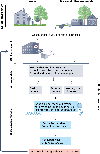Integrating natural commensals and pathogens into preclinical mouse models
- PMID: 39562646
- PMCID: PMC12126596
- DOI: 10.1038/s41577-024-01108-3
Integrating natural commensals and pathogens into preclinical mouse models
Abstract
Fundamental discoveries in many aspects of mammalian physiology have been made using laboratory mice as research models. These studies have been facilitated by the genetic tractability and inbreeding of such mice, the large set of immunological reagents that are available, and the establishment of environmentally controlled, high-throughput facilities. Such facilities typically include barriers to keep the mouse colonies free of pathogens and the frequent re-derivation of the mice severely limits their commensal flora. Because humans have co-evolved with microorganisms and are exposed to a variety of pathogens, a growing community of researchers posits that preclinical disease research can be improved by studying mice in the context of the microbiota and pathogens that they would encounter in the natural world. Here, we provide a perspective of how these different approaches can be combined and integrated to improve existing mouse models to enhance our understanding of disease mechanisms and develop new therapies for humans. We also propose that the term 'mice with natural microbiota' is more appropriate for describing these models than existing terms such as 'dirty mice'.
© 2024. This is a U.S. Government work and not under copyright protection in the US; foreign copyright protection may apply.
Conflict of interest statement
Competing interests: B.R. discloses that the National Institute of Diabetes and Digestive and Kidney Diseases granted a license on the WildR mice to Taconic Biosciences and has a Collaborative Research Agreement and Development Award with Genentech. The remaining authors declare no competing interests.
Figures

References
-
- Virgin HW, Wherry EJ & Ahmed R Redefining chronic viral infection. Cell 138, 30–50 (2009). - PubMed
Publication types
MeSH terms
Grants and funding
LinkOut - more resources
Full Text Sources

